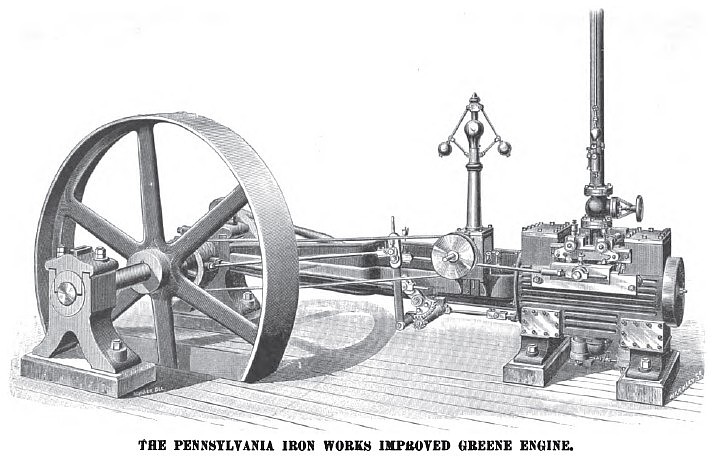|
Title: |
1890 Article-Pennsylvania Iron Works Co., Greene Steam Engine |
|
Source: |
The Steam User 1890 pg 3 |
|
Insert Date: |
4/12/2011 8:27:18 PM |
GREENE ENGINE.
On the opposite page is shown an engraving of the improved Greene Engine, which is built by the Pennsylvania Iron Works, at Philadelphia, Pa. This company have recently obtained possession of patents, issued this year (1888) to N. T. Greene, of Providence, R. L, for various improvements in the construction of an automatic steam-engine, and are now building engines with these improvements from 75 to 1,000 horse-power.
The Girder pattern is used for bed-plate, which is of great strength and of symmetrical appearance. The valve gear is detachable, and the governor so controls it that the cut-off may take place from zero to full stroke. The lead under all circumstances remains constant, the exhaust is entirely free in all conditions of labor, and the clearance is reduced to an absolute minimum. The valves are of the flat-slide pattern, and are four in number—two steam and two exhaust; they cannot twist or rock, as the power which moves them is applied parallel to and in a line with their seats. The steam-valves when tripped are shut by vacuum dash-pots, thereby ensuring a quick cut-off and the positive closing of the port under all circumstances of speed and pressure. The steam-valves are operated by toes on the inner ends of two rock-shafts that connect with the valve-stems outside the steam chest. The outer ends of the rock-shafts are furnished with steel tipped toes.
There is a sliding bar carrying tappets, which receives a reciprocating rectilinear motion from an eccentric on the main shaft. Below the sliding bar is a rock-shaft with cams connected with the governor, which receives an up and down motion from a reverse action of the governor balls.
The tappets in the sliding-bar are attached to the cams, and elevated or depressed in the bar by the action of the governor. As the sliding-bar moves in the direction of the arrow, one of the tappets is brought in contact with the inner face of the toe on the rock lever, causing it to turn on its axis, thereby opening the steam-valve at one end of the cylinder. At the same moment the other tappet comes in contact with the outer face of the other toe, and as the surfaces are beveled, the toe is forced up into the socket until the tappet passes under, when it drops by gravity alone into its original position, to be operated upon in its turn when the motion of the sliding-bar is reversed.
As a result of this motion, the tappets always give the valves the same lead, and as the bar moves in a straight line while the toe describes the arc of a circle, the tappet will pass by and liberate the toe, which is brought back to its original position by the dash-pot, which thus closes the valve and cuts off the steam. The liberation of the toes will take place sooner or later according to the elevation of the tappets; that is, the lower the tappets are, the sooner the toes will be liberated, and vice versa. By the elevation or depression of the cams, the period of closing the valves is changed, while the period of opening them remains the same. The adjustment of the cams is effected directly by the governor.
Both the exhaust-valves and seats are convenient of access, and removable from the outside of cylinder. The valves receive their motion from a separate eccentric, thus allowing of easy adjustment without interference with the steam-valve mechanism. All the connections are on the outside, are few in number, and have ample bearing surfaces, ensuring freedom from rapid wear and derangement.
The cross-head gibs are directly opposite the centre of pin, thus avoiding any cross strain upon the piston-rod; a lack of attention to this point has been the cause of many serious accidents. The steam-ports are large, thus ensuring the full pressure of steam to the point of cut-off. |
|
 1890 Pennsylvania Iron Works Co., Greene Steam Engine
1890 Pennsylvania Iron Works Co., Greene Steam Engine
|
|